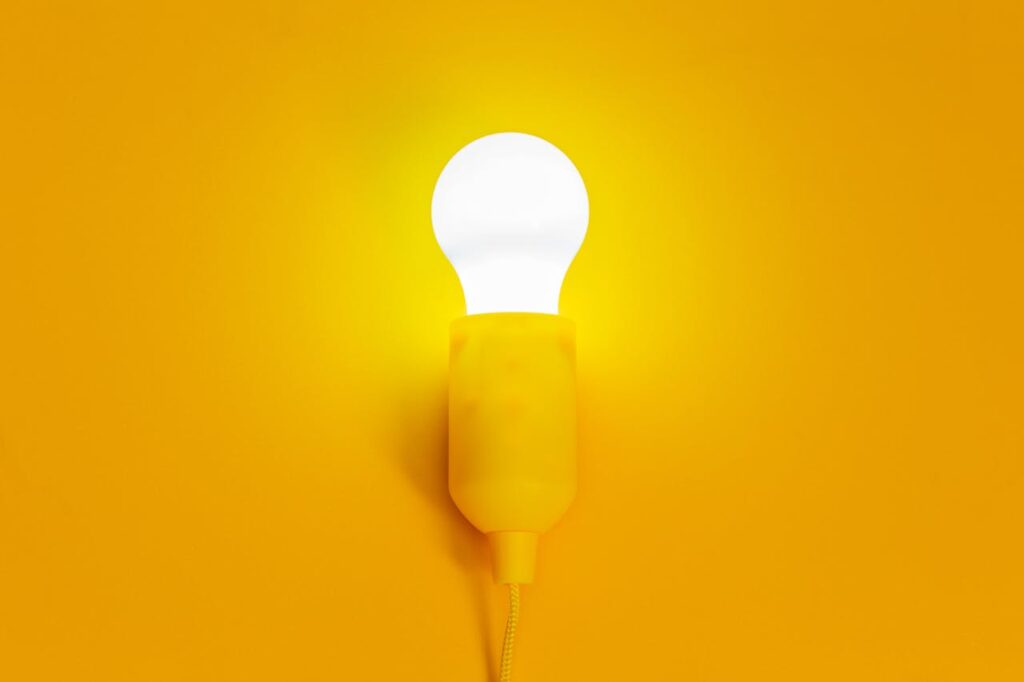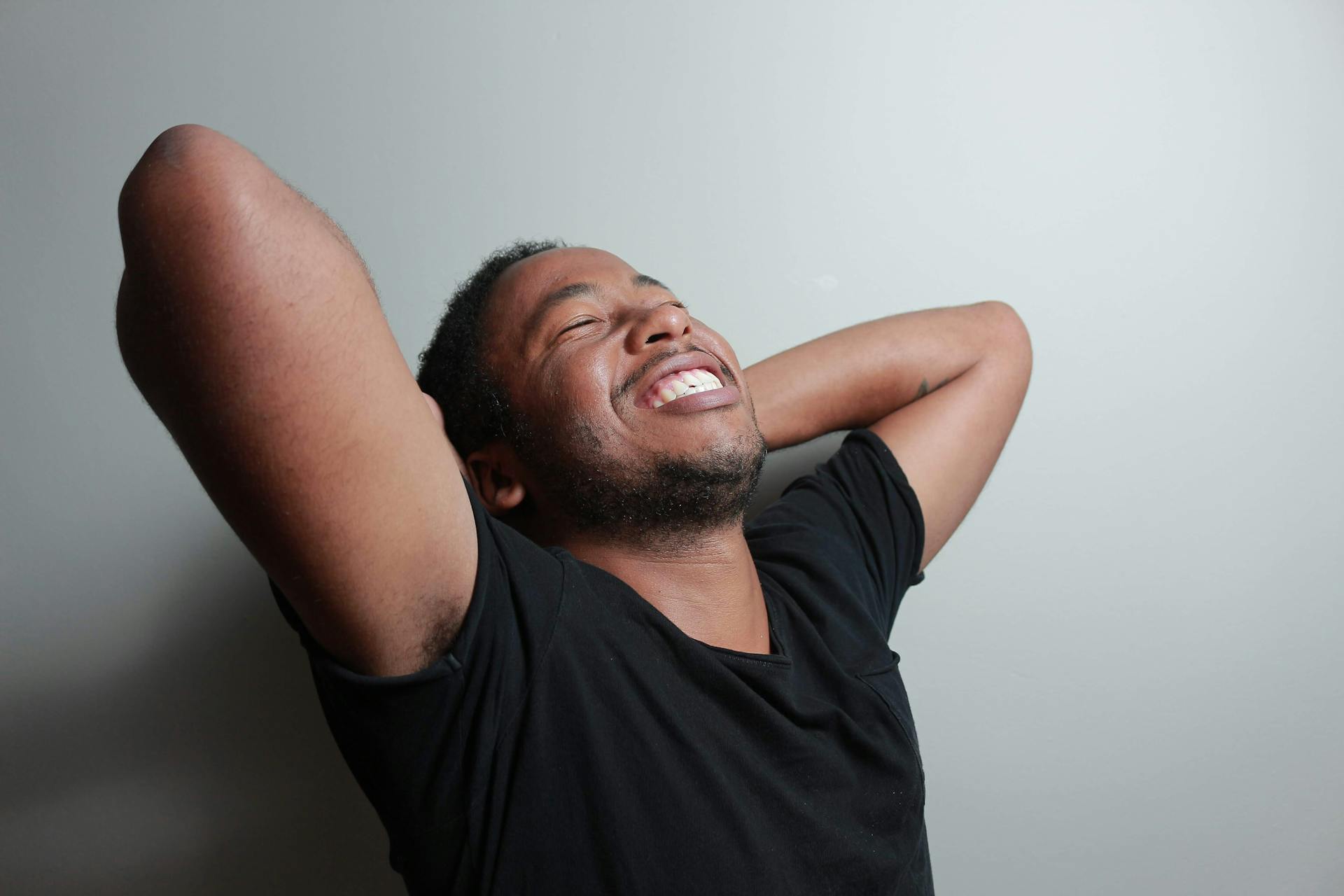What do you do when you feel lost and stressed? Do you go for a run and activate your body? Do you go and meet your friends for lunch? Or do you, like me, sometimes try to crack a joke at your own misery?
Expressive arts like comedy writing, story telling, or drawing, are activities that allow many of us to externalise our inner, often unspeakable experiences of life, and through this process, regulate down our emotions, reconnect, and re-empower ourselves with hope.
Today, and as a follow up to our interview with Jayman on the All About Trauma Lives, I am going to look at one branch of the wide field of therapeutic interventions that use expressive arts activities as their foundation for mental wellbeing, and try to explain in more details why the stuff that makes comedy, such as humour and punchlines, and the effects of it, such as laughter, make us heal.
“Imagination is central to recovery”, meaning that all therapeutic approaches that use imagination, such as improv, drama therapy, sandtray therapy and all other expressive arts therapy, are viable therapeutic approaches because they allow those parts of the brain that normally shut down after a traumatic event, to re-engage and come online.

Why Humor Is More Than Just a Laugh
In the world of therapeutic recovery interventions for PTSD, depression or even suicidal ideation, humor might seem an unexpected ally, but according to science humor and laughter are powerful tools for improved connectedness, hope, identity and empowerment.
The mechanisms behind the influence of humour and laughter are complex, but a recent systematic review by Kafle et al. (2023) shows that activation of confidence in a new skill, promotion of social skills, opportunities for social interaction, vulnerability, and most importantly cognitive flexibility might all be involved in relieving us from rigid and negative patterns of thinking.
Comedy and humour interventions, they conclude, are beneficial to help shift our perspective, regulate emotions, and reconnect with others.
From a therapeutic perspective Kafle’s study is a reminder that laughter and the use of humour might be informal measures of how rigid or flexible our minds have become, whether we are a therapist or a client. I found this out on my own skin at the end of my psychology honours degree, when, suddenly, at the age of 35, I had become suicidal.
It was in 2010, after a divorce that had left me completely empty of self-worth and confidence. And in the early weeks and months after being saved by my neighbour, who by chance happened to pass by and see the deplorable state I was in, I reflected on how overly serious a person I had become.
I was overly concerned with the state of the world, overly concerned with the story of destruction of Earth, and awfully convinced that knowing and focusing on this aspect of our humanity was all that mattered in life.
I recycled every bottle I bought, saved water from my sink to water the plants, collected leaves people threw out to turn them into compost, and looked through every Pinterest recycling craft post to grow – so I thought – in my capacity to save the world!.
But such focus and choices had come at palpable cost. Counterintuitively, the guy that was always ahead of everyone in growing and being aware of the state of the world, had become so rigid in his understanding of what mattered, that he couldn’t laugh anymore.
Sure, in the dark corners of my self-imposed solitude, I glowed with pride for having one of the “lowest footprints in the neighbourhood”, but meanwhile, I had lost touch with joy, I did not know how to be light anymore, how to see the bright side of things, the funny in the tragic, and how to flip around a story of death and loss, into something that was relatively ok for life as a whole. The Earth’s story was not about me, but somehow, it had become my own story.
So I knew, then, that I was faced with the important and urgent need to radically change something about my character. I was now seriously…erhhmm, I mean playfully, ready to devote myself to being able to make fun of things.
The project of writing my final thesis for my psychology degree graduation gave me an opportunity to walk in this direction, and on a spur of intuition, I decided to focus on how Stand Up Comedians use humour to make fun of the impossible.
Secretly, I hoped to learn the skill of carrying my thoughts to a completely different conclusion whenever this was fit and necessary to keep my mental health. No one better than Stand Up Comedians could help me do this, I thought.
The Comedian’s Superpower: Cognitive Flexibility
It was around this time of personal reflection that I stumbled on an important insight about why humour had become so important to me now. Since I was an adolescent, I remember never quite liking people who always made jokes out of things, or out of anything really. Well, in the spirit of humour today I can self-deprecatingly confess that this was at least in part because they got all the girls and I got none!
But in even more of a confessionary line, I admit that I had always found these “jokers” shallow and unable to connect with people as deeply as I could. You see, I was the one to whom all the girls confessed their deepest pains, so shouldn’t I have been enough of a reason for them to choose me?
I wore the empath badge of honour, and declared, with my chin raised to the sky, that it was thanks to people like me that humanity was not yet on the verge of collapse.
Empathy and compassion for the suffering of others, and for the suffering of women in particular, was what the world lacked the most, and so it was natural for me to take care of my filthy rich classmate who had lost her pencil and had begun crying as if her parents had been sent to Auschwitz!
But on a more serious note, this dislike for the “comedian in the room” was curious, and upon reflecting on it a bit longer, at now age 35 and not 12, I came across an important insight. Those who afforded making jokes of someone’s misery were doing the opposite of what an empath like me would normally do because this allowed them to distance themselves from the pain of others, not approach it.
As an empath, if, metaphorically speaking, someone fell in front of me and got hurt, my first response was always to “feel with them”, to be com-passionate as we say, and to kneel and stay with their pain. As a well conditioned empath, I moved towards the pain of others, not away.
But the comedian in the room would do precisely the opposite, and now I intuitively understood why. Through a joke, the comic would allow themselves to “feel separate from” the hurt, distant from the event, and would objectify the event of hurt as external to them and not belonging to the realm of their lived experience.
And as we shall see, it is this capacity de-dramatize, this capacity for distancing oneself from the pain of others, that gets not only the comic individual laughing, but patients suffering from suicidal ideation and depression, as well as people around the comic, to release important levels of stress.
Stand Up Comedians are very skilled in doing something that I found terribly difficult to do, make sudden shifts in thinking, and arrive at improbable conclusions. So, during recovery, besides watching a lot of Stand Up Comedy, I also started to look into what Stand Up Comedians were actually doing to be able to talk about difficult topics in a way that could make thousands of people join in a concert of laughter.

It’s here that I discovered terms like the “punchline”, and the “set up”, and realised that when I listened to Stand Up Comedians, they were able to lead me somewhere with their stories but then suddenly turn the course of their trajectory to take me to an end point I could have never expected.
It was as if the Stand Up Comedian, or perhaps all naturally funny people for that matter, had the super power to reveal a bright landscape at the end of every dark tunnel they got us into. It is when this revelation was made, that me, you, and everyone else laughed.
And now in studying this skill, I realised that it was this particular capacity for remaining somewhat emotionally detached from the harsh reality of life, that provided them with cognitive flexibility to take turns that would have been impossible for a deeply committed empath, with a badge of honour like me, to even see.
Joy, laughter, the lightness of being, care-freeness, and play had always been there for me to connect with, but something had blinded me to their presence. Like a train on a monorail track, I had been rigidly moving forward towards a now predictable end point.
So it was this particular ability of the comic to see the unimaginable in the “obvious”, that I wanted to develop and perhaps re-discover. I began contacting Stand Up Comedians all over the world, from New Zealand to Germany, from Brazil to, of course, stand up comedy land, the USA, had deep long conversations with them, and soon enough began to understand why their work was short of being a gift sent from heaven!
You can read the full thesis and friendly report I sent to all the comedians here, but in this article I am about to share some of their best quotes and findings, so stick around.
Taming Tragedy with Absurdity
Humor has for so long allowed people to view difficult circumstances through a less intimidating lens, facilitating a playful exploration of connections that might not be relevant to the immediate needs of the sufferer, but that nevertheless play a fundamental role in maintaining social regulation and cognitive flexibility. As Jayman shared with us LIVE: “Comedy recycles everything… even the most terrible experiences.”.
Humor is the lens through which we can transform painful memories into something manageable because it allows us to normalise it with some equanimity. The comedian who laughs at the hurt of a person is really reminding us that hurt does not originate in the here and now only, but it is something many others experience in many other circumstances. In de-dramatizing the event, he or she also de-localises it, and this is an important antidote to narrow focus.
As empaths, we have a tendency to fall in line with the hurt feelings of others, and with it, to become narrowly centered on the present events at stake. At some level, we become ego-centrically centered on the people and events we are suffering with, sometimes even inadvertently fueling a collective and dysfunctional identity of victimhood.
The whole world falls inward and around us. But the comedian resolves that pitfall by allowing us to recuperate our capacity to dissolve hurt and detach from pain. “It’s all cool, stand up and look around” says the comedian.
As the Stand Up Comedian Jayman shares in the interview: “My first attempt at writing about my story was boring because I was trying to be dramatic. Then I decided to write it absurdly, and it came alive.”.
Bringing out the absurd in his story of hurt allowed him to highlight the oddity of the events he had been subjected to, and through this recognise that what was odd and absurd about them, was also part of a much grander play of events that are connected to much broader principles of life and death, destruction and creation, chaos and order.
Let me give you a personal example of what I think comedian Jayman achieved in bringing to life his complex story of trauma. My sister drowned when I was a little boy. We were at the beach with my father. My mother was not with us, because, well, she had died a couple of years before. I was playing with my sister on the beach when she drowned, and as it turns out my father had been windsurfing with a girl in a bikini he had just met.
For so long I looked at my father leaving a 3 and a 5 years old children on a beach alone as tragic proof of the incapacity of men to be nurturing, but I would be lying if I did not share that I also felt that my explanation lacked sophistication.
“Isn’t it so obvious that two small children like us should not be left alone on a beach?” I would ask myself. Well! Obvious from an empathic perspective, yes! But from the perspective of a 24 year old young man who has two young children and has little to no clue how to take care of them, perhaps not!
Today, the mental flexibility that the comic in me affords, speculates that he was working very hard to find us a mom, or rather, a permanent baby-sitter who could cook, wash, organise and tend to all our needs for no monthly payments and more free time to run after more girls in bikinis!
Today, the comic in me also thinks he had forgotten how to make sand castles and he was terribly embarrassed to let us realise that! It doesn’t really matter, because today, unlike then, I can mix what I believe might have likely been happening in him that day, with imaginative speculations that keep my brain flexible, and away from rigid conclusions.
I think, as I recently heard Dr. Bessel Van der Kolk on a live webinar I was attending for a course on trauma informed care, “Imagination is central to recovery”, meaning that all therapeutic approaches that use imagination, such as improv, drama therapy, sandtray therapy and all other expressive arts therapy, are viable therapeutic approaches because they allow those parts of the brain that normally shut down after a traumatic event, to re-engage and come online.

Focusing on the absurd in our conditions of suffering with the intent to connect that absurd to life in general, normalises our victimhood, and brings back into the realm of our suffering that which we lose when we focus too closely on it, mental agility.
Asking ourselves to reconsider the assumptions we make about what is wrong and what is right, what is to be feared and what is to be considered safe, what is ultimately to be seen as different or familiar, moral or immoral, an enemy or a friend is cognitively demanding but at the same time healing because it re-engages our cognitions in places of our brain where cognition has been shut-off.
The Science Behind Laughter and Healing
It’s a pleasant reckoning, for those like me who are fond of mindfulness based practices, that science finds humor to facilitate “decentering”, the same effect found in Mindfulness Based cognitive therapy, allowing clients to step back from their pain and regain important perspectives on their fearful experiences (Moore et al, 2022; Lo et al. 2014; Bieling et al, 2012).
And more research supports the notion that humour improves mood disturbances. This meta-analysis by Zhao et al. (2019) revealed that laughter and humour interventions are effective in relieving depression, anxiety, and improve sleep quality in adults, while Rnic et al. (2016) shows that both Affiliative and Self-Enhancing humor styles, rather than maladaptive Aggressive and Self-Defeating humor, are associated with reduced cognitive distortions (The latter humor style may be used as a coping strategy for dealing with distorted thinking but ultimately backfires and results in increased dysphoria).
All in all then, highlighting the absurdity of our experiences breaks the crude logic of pain that most of us fall prey to and eventually identify with after a traumatic event, such as “X person did X thing to me, and therefore I am now suffering”. This pushes us into the narrow rigid confines of what I call “identified victimhood”, and while this position has some social advantages, it’s a dangerous place to inhabit within ourselves.
The cognitive model of verbal humour greatly contributes to the transformation of this fixed and unchangeable mindset, and shifts us into innovative and flexible ways of thinking about our place in the world, and the world at large (Li et al, 2018), that makes healing possible.
From Laughter to The Body’s Chemical Pathways to Healing
A lot has been shown to be implicated in the process of writing down our thoughts and emotions with humour, and yet an analysis of the benefits of the playful art of comedy would remain only skin deep if we did not acknowledge the physiological dimensions of it. In fact, during my thesis, I came to believe that to be properly understood, comedy had to be seen, perhaps first and foremost, as a deep, internal, physical experience, just like trauma actually is.
According to Davila Ross et al. (2009), laughter, which is what humour aims at, is an old primate’s evolutionary mechanism to signal that danger has passed. In their natural environments, apes roam together. If the group stops because it hears a brushing noise in the tall grasses of the Savannah, but then realises it’s just a little lizard moving around, the group communicates a return to safety by way of a “ah ah ah ah ah” (ape noises) sound.
If you thought that this sounds pretty close to how we primate humans laugh, it’s because it does. The keystone notion in stand-up comedy that laughter emerges as a consequence of tension release, echoes strongly with our ancestral roots.
If groups of ancient primates experienced a resonating empathic unity after finding there was no tiger behind a bush, groups of homo sapiens quite possibly experience very similar states after finding their fears about depression, suicide, racism, sexism and so on, are nothing but an illusion of their minds.
The stories they had come to rigidly believe in, are now seen as unreal threats. As Jayman describes it, “The moment you start laughing at something that scares you, this thing does not scare you anymore.” This is because the brain’s right hemisphere plays a key role in both verbal humor and depressive moods.
Interestingly, verbal humor helps to regulate and normalize the activity associated with depressive states, encouraging our brain to shift from rigid, fixed thought patterns tied to depression toward more flexible and creative ways of thinking. This transformative effect highlights humor’s potential as a powerful tool for fostering cognitive and emotional well-being.
What is more, the primal b(uuuuhhh)s and l(aaaahhhhs)ghs the comedians hear, activate complex physiological responses. Exhilarated laughter involving open-mouth smiling, orbicularis oculi muscle action (Hess & Thibault, 2009), basic vocalizations, postural relaxation, and shaking of the shoulder and torso, are shown to elevate the heart rate, increase expiration (Ruch, 1993), increase blood oxygenation, reduce cortisol, produce growth hormones and epinephrine (Berk et al., 1989), and even, in some studies, significantly increase the presence of natural killer cells, the cells involved in the body’s response to virus, infection, and certain cancers (Baim P, 1998; Epstein & Joker, 2007).
The quick activation and release of the sympathetic and parasympathetic nervous systems offers a pathway to hormonal and neurochemical releases that are very enjoyable and beneficial.
Studies have shown that laughter can act as a catalyst for mental and physical well-being, reducing stress hormones like cortisol while boosting mood-enhancing chemicals such as serotonin and dopamine (Yim, 2016). In the words of IDK:
“the first time I had a good set, like a really good set I came off stage and the first thought that came to me was, now I understand why performance artists do so much cocaine, because I’ve never done cocaine, but I can’t imagine how you can otherwise replicate the feeling of coming off killing a room of 200 people like I had just done.” (Comedian IDK)
The effects of these high are so real that repeated experiencing of them can have, in the words of some comedians, seemingly addictive consequences:
“you will talk to a lot of comedians and they’ll tell you that they got hooked because it is absolutely a drug. It’s basically dopamine and adrenaline wired directly through your brain. You can’t stop doing it after a while. It is straight up an addiction in the classical sense of the word” (IDK).
or from Jimmy Carr:
I like to think of myself as a drug dealer, but I will never be taken by the FEDs because the drugs are already on you, you have got the endorphins there, you have got the good shit, and it’s about letting that out, in a very sort of organic natural high of laughter (Carr, YouTube MIN. 11)
When a stand-up comedian is producing the desired effect of laughter, the psychology that ensues taps deep into everyone’s body. Mind rushes into the body iteratively and “when that works, you’re surfing a wave, and you don’t even necessarily notice what you’re saying, you’re just on autopilot… it feels like my mouth has just directly connected to my non-conscious brain and it works.” (IDK).
Listening to how this process unravels on stage is fascinating to say the least:
“somebody had just ended their performance by doing a really dark remark about death, and everybody in the audience was feeling tense, and I’m the host, and I have to pick that up because everybody was bombed.
And I’m like “well he’s right you know?! We’re all gonna die!”, and there’s this woman in the crowd who is about sixty years old, and she says “yeah I don’t care about death”, and I made a remark on the fact that she is old and about to die and how she shouldn’t care and just have fun while she has time, and it just broke all the tension and this moment’s reaction where everybody exploded was a pure moment, where people forget they are watching a show, and they’re just connected with themselves I think.” (Billy)
This process of laughter is something certain forms of therapy have tapped into. I still am not much of a laughing guy unfortunately – that seriousness of mine has never quite worn off – but today I certainly appreciate and validate humour and laughter in my clients and myself like never before, and in so doing I look for opportunities to laugh with my clients about their “misery” in a way that encourages detachment from it.
And in fact, the application of humour in therapeutic settings, including laughter therapy and laughter yoga, has demonstrated significant reductions in depression, anxiety, and even physical pain by improving sleep quality and emotional resilience (Zhao et al., 2019).
Laughter has also been found to increase endorphins and modulate neurochemical activity in ways that align with alleviating depressive symptoms. In contexts as varied as elderly care and cancer recovery, structured laughter programs have enhanced quality of life and emotional well-being, showcasing laughter’s versatility as a healing mechanism (Heidari et al., 2020; Lee et al., 2020).
What comedians describe as an almost addictive high from triggering laughter—a flood of dopamine and adrenaline—resonates with these findings, highlighting laughter’s ability to forge connections between mind and body, offering both immediate relief and longer-term psychological benefits.
The therapeutic potential of laughter extends beyond traditional therapeutic contexts and into the realm of medical clowning, an innovative intervention that leverages humor to transform healthcare experiences. Studies have consistently shown that clown therapy significantly reduces anxiety and pain, particularly in children undergoing medical procedures or surgeries (Vagnoli et al., 2005; Sridharan & Sivaramakrishnan, 2016).
These benefits are not confined to patients alone; parents also report lower anxiety levels when clowns are present during these stressful moments. Medical clowning not only alleviates physical discomfort but also addresses the emotional and psychological toll of hospitalization. By fostering a lighter, more humanized environment, clowns help patients, families, and staff navigate the stress of clinical settings with greater resilience and positivity (Dionigi & Canestrari, 2016).
The physiological benefits are equally remarkable; laughter induced by clowns triggers endorphins, reduces stress-related hormones, and bolsters immune responses, contributing to both mental and physical recovery (Matabuena-Gómez-Limón et al., 2020).
In this way, laughter becomes a bridge—not only between mind and body but also between patient and caregiver, creating spaces for healing that go beyond traditional medicine.

Conclusion
The expressive art of Comedy resolves what Jayman calls a catch 22 situation. “To heal emotional connection issues, you have to connect with someone, but your issues prevent you from connecting”. The internal inhibition that traumatic experiences create in connecting with ourselves, translate in generalised difficulties to connect with others. If we have suffered violence, we become afraid of connecting with other people’s anger, or even expressing anger ourselves in the first place, thus cutting ourselves from a large portion of life.
Humor presents trauma survivors with a transformative tool to reclaim their stories and rebuild emotional connectedness with themselves and others. It disrupts the isolating cycle of pain and victimhood, inviting a re-engagement with life through the lens of creative thought. The absurd becomes the key to a reignited imagination. As trauma survivors weave humor into their narratives, they tap into the brain’s innate reward system, fostering self-reliance, reducing stress, and sparking mental clarity.
Jayman’s journey exemplifies this beautifully—turning past pain into a source of strength, humor becomes a bridge between fear and hope, between isolation and connection. Sharing these stories, as Jayman did, reminds us that even the darkest chapters can be rewritten with courage, creativity, and humor.
Finally humor invites clients to view trauma differently, shifting their emotional response towards a set of physiological mechanisms that release endorphins and create a natural “high,” reducing stress and promoting mental clarity. Developmental trauma can leave individuals feeling detached and distrusting but humor helps rebuild those neural and relational connections that enable us to live less fearfully in the world.
Likewise, expressive arts like Stand Up Comedy allow us to do what Jayman beautifully did on our All About Trauma program, they provide an avenue for talking openly about trauma…” the best way to put an end to it.” says Jayman.
With all of this said, what are your thoughts about the use of humour and laughter as an active tool for healing trauma and soften its rigid mindset? Has imagination healed any parts of yourself? Let me know what you think with an email to delatierracounseling@gmail.com.
